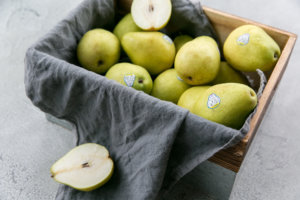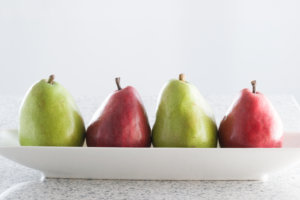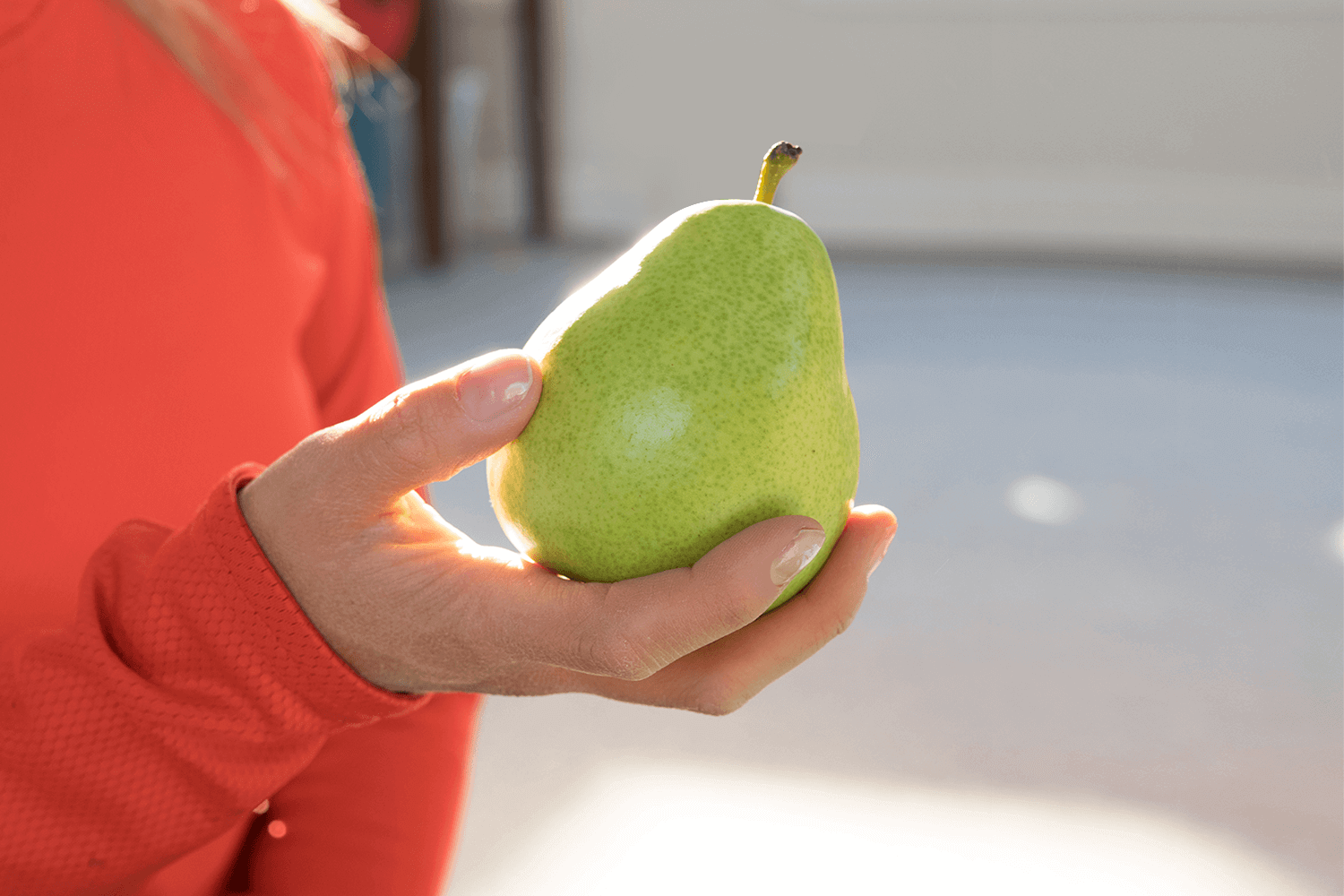How to Ripen Pears
|
Originally published in November 2013; updated September 2022.
Pears are my latest fruit addiction. I love this fruit for its unique, grainy texture and sweet, juicy flavor. In fact, combining a ripe pear with gourmet cheese and crackers has turned into an easy and tasty appetizer (and admittedly, sometimes a dinner) at my house. In this post, I’ll answer the common pear ripening question by showing you how to ripen pears quickly with two methods you can try out at home. I’ll also share a simple strategy for determining when a pear is ripe and ready to eat.

Farm Fresh Pears
Growers harvest pears once they are mature, but in the pear world, maturity means the fruit is not fully ripened. If growers allowed pears to ripen on the tree, the core of the fruit would breakdown. This causes an unappetizing mushy or mealy texture when they arrive at grocery stores (and no one wants that!). Harvesting pears at the right pressures leads to fruit that will ripen to good quality. At Stemilt, we do just that and cool them immediately after harvest in order to deliver premium pears to your stores.
The most common question we get is “how do you ripen pears?” or “how do you know when a pear is ripe?” Indeed, ripening a pear can be tricky due to the fact that most pears do not change color as they ripen, and pears are typically close to – but not quite ripe – when you purchase them at the store.
How To Ripen Pears: In a Brown Paper Bag
If the pears you brought home from the store are still a little hard and not quite ripe, you can try softening them in a bag at room temperature. Cold temperatures slow down the ripening process, so storing ripe pears in the refrigerator is the best way to maintain quality.
Like bananas and avocados, pears naturally release ethylene gas (a ripening hormone) as they ripen. Placing the pears in a brown paper bag keeps ethylene close to the fruit and speeds up ripening. Any bag would work, but paper is preferred over plastic as it allows the fruit to breathe.
 How To Ripen A Pear With Other Ethylene-Producing Fruits
How To Ripen A Pear With Other Ethylene-Producing Fruits
Another way to ripen pears is to place them next to fruits like bananas, avocados, or apples (perhaps in a fruit bowl). These fruits also give off ethylene gas, and the extra exposure to ethylene induces ripening in pears.
To really speed up the pear ripening process, combine two ethylene producing fruits (such as bananas + pears) in a paper bag and leave the bag at room temperature. Don’t forget to check the pears often for ripeness if you use this
method.
How To Know When A Pear Is Ripe?
Regardless of your preferred method, you’ll need to know how to tell if a pear is ready to eat. Some pears, like the Bartlett variety, change color as they ripen (Bartlett goes from green to yellow), but many other pears, including d’Anjou, do not.
To determine ripeness, hold the pear in the palm of your hand. Then, gently apply pressure into the neck of the pear with your thumb. Once the skin of the pear gives to that pressure (even slightly), it is ripe and ready to eat.
There is definitely a fine line when it comes to pear ripening (they can quickly go from underripe to overripe), and so it’s important to check the neck for ripeness daily, especially when you are following a method that speeds up ripening. Most pears should be ready to eat within a few days after purchase. Be sure to place ripe pears that you are not using in the refrigerator to maximize freshness.
Share with us! What is your preferred method for ripening pears? Is it different from the two methods described above?

 How To Ripen A Pear With Other Ethylene-Producing Fruits
How To Ripen A Pear With Other Ethylene-Producing Fruits
16 Comments. Leave new
Hi:I bought 2 bags of Stemilt pears and both bags had gone bad with half of the pears skin going bad that is quite a waste when you pay $1.00 per lb. I think you should inform the Canadian Superstore about storage of the pears..Thanks Nestor Hrabinski.
I sent you message about your pears.
Thanks Hector, and sorry for the late reply. I will alert our team of this issue now.
Very helpful. Your knowledge shines through. Thanks
Just bought a 2# bag of your organic bartlett pears, every pears is in excellent condition, but just wondering what the white residue is that is on each pear. After handling the pears, my hands feel very dry. Please advise.
Hi Pat! I’m so glad you enjoyed our pears. This is exactly what we aim for. The white residue is a natural clay that we use to prevent the fruit from sunburn. We try to wash it off prior to packing, but some areas are impossible to clean off. You can read more about it here: https://www.stemilt.com/about-us/fresh-fruit-faqs/#pear-faq
I have had a small bag of D’Anjou pears out and in a wire basket for almost a week. I tried the banana + pear in a bag method on a couple as well.
They are all still rock hard. One gave a little bit at stem end so I cut it up. It was very hard and crunchy still. Are D’Anjou pears particularly hard to ripen? Do they take a long time? I am dying to eat them!!
Hi Katy,
They can be difficult to ripen, but should’ve ripened after a week! Can you tell me where you purchased these pears? I’d like to let our quality team know of this issue you are having. Sorry they aren’t ripening up for you. This is definitely not what we want. You could give it a few more days to see if something will change, but I worry they may brown on the inside before they ripen this time around because of how long it is taking.
Hello, I am also having the same issues as Katy Wilkins. Purchased Bartlett pears 2 weeks ago from Canadian Superstore and they are in my fruit bowl. Still remain rock hard. Cut one up and not all that pleasant to eat. Very odd. Thanks
Hi Angela, Very sorry about that! Are you sure they are Bartlett pears from Stemilt? We have been out of those for some time. Bartlett’s will turn from green to yellow when ripe. D’Anjou pears do not, and will need to sit by a ethylene producing fruit like a banana to ripen.
Thanks. I have two pear trees in my yard (one D’Anjou and one Bartlett), and the decision when to pick the fruit is challenging. If I leave them on the tree too long – the wasp and bees harvest the fruit, leaving only the skin. Many of my friends from Asia Region prefer the pears crispy and firm over my preference for softness. Will try brown paper bag recommendation.
If you have a way to test the pressure of the pear, that is how our growers determine when to pick. You can also follow days post bloom as a guide. Washington State University is a great resource for these specifics. Hope you have better luck this fall!
Comice pears are my favorites, but they don’t seem to sell as well as Bartlett’s, and are more expensive. Worth the extra money though.
Question #1 – are Comice pears the same thing as “Riviera” pears, that are sold in commercial Christmas variety packages?
Question #2 – Bartlett pears seem different to me than they were in years gone by. They are a different shape, with kind of a knob on top, and all exactly the same size in the supermarket. and already a solid yellow when they are rock hard. Also they don’t have the nice sweet flavor they used to have, but more of a watery bitter taste. Why is this?
Hi Marilyn, so glad you love Comice! I’m not sure if they are the same as Riviera pears. That would be a great question for whomever is shipping those Christmas packs! In regards to Bartlett, it would be helpful to know if that is our brand you are noticing and where you purchased. This is something we would certainly want to fix! I had a Bartlett yesterday and it was perfectly ripe and full of sweet, juice. I hope you can find one like that soon!!
i dont buy peaches from Superstore anymore.
They go rotten and mushy and never go ripe.
Over a period of 2 or 3 years I have never been able to eat one. I must have thrown away $30 to $40 dollars worth of fruit.
Now pears…. I have a 30% chance of being able to eat what I buy from them.
This never used to be like that, they would go juicy and ripe in a couple of days, but not anymore.
Pears remain hard but if you cut them open they are brown and rotting at the core.
Now the same as peaches. Hard on the outside, rotting on the inside. It doesn’t matter how you store them
The only way to buy these fruits at Superstore in in a can, otherwise go to the Iranian supermarkets or elsewhere where I have better luck.
I can’t afford to buy at Superstore.
Hello W. Palmer! We are sorry you are having this issue with peaches and pears. Can you tell me if this is specific to Stemilt brand fruit and which Superstore location you are at? I would like to share this feedback with our team so that we can improve this experience if it is our fruit. Thank you for sharing!